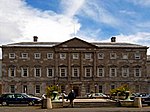Oireachtas
| logo | Parliament building |
|---|---|

|

|
| Basic data | |
| Seat: |
Leinster House , Dublin |
| MPs: | 218 (158 MPs and 60 Senators ) |
| Current legislative period | |
| Chair: |
President Michael D. Higgins Cathaoirleach Denis O'Donovan ( FF ) Ceann Comhairle Seán Ó Fearghaíl ( FF ) |
| Website | |
| www.oireachtas.ie | |
The Oireachtas [ ˈɛɾʲəxt̪əs ] (with ir. Article to tOireachtas [ ən̪ ˈt̪ɛɾʲəxt̪əs ], occasionally also Oireachtas Éireann ) is the national parliament of the Republic of Ireland . It consists of the President of Ireland and two chambers, the Dáil Éireann (House of Commons) and the Senate ( Seanad Éireann also House of Lords). The Dáil has further powers. Both chambers of the Oireachtas are located in Leinster House in Dublin .
Powers
In theory, before a law comes into force, it has to be passed by the Dáil and the Seanad and then signed by the President. However, the Dáil is the authoritative body in Irish law as the President is normally required to sign any law passed by both Houses of the Oireachtas and the Seanad can usually only delay a law but not prevent it.
The Constitution of Ireland gives the Oireachtas exclusive rights
- Legislation, including the budget (legislation can be delegated to subordinate bodies, but this has not happened yet)
- Proposing constitutional amendments, which, however, first have to be confirmed by a referendum
- Formation of an army
- Implementation of international treaties into Irish law
- Adoption of laws with extra-territorial implications (in line with similar practices in other countries)
- Ordinance of emergency laws when a state of emergency has been declared
However, the powers of the Oireachtas are restricted by the following regulations:
- Laws are invalid when they are unconstitutional
- EU laws take precedence over laws of the Oireachtas
- Acts may not be criminalized retrospectively
- Laws to reinstate the death penalty are illegal, even during a state of emergency
- The laws of the Oireachtas under Articles 2 and 3 of the Constitution apply only to the 26 counties of the Republic of Ireland and not to Northern Ireland
history
The word Oireachtas comes from Irish , originally a consultative assembly of free men. It is the name of two parliaments in Irish history: the Parliament for the Republic of Ireland since 1937 and the Parliament of the Irish Free State (1922–1937).
The first parliament in Ireland existed as the " Parliament of Ireland " until 1801. Its scope covered the entire Irish island, but was - more or less - subordinate to the English and later British parliament . It consisted of the King of Ireland, the House of Lords (Chamber of Nobles) and the House of Commons (People's Chamber). In 1801, with the Act of Union , it abolished itself.
The next legislation in Ireland did not come into existence until 1919: an extra-legal parliament with only one chamber, known as Dáil Éireann (roughly: Assembly of Ireland). It was formed by Irish nationalists. While the first Dáil was the official legislative power for all of Ireland, the British government formed another parliament in 1920: the " Parliament of Southern Ireland ". However, this was boycotted by the Irish nationalists and was therefore never able to develop its full power. It was formed by the British King, the "People's Chamber of Southern Ireland " ( House of Commons of Southern Ireland ) and the Senate ( Senate of Southern Ireland ). It was abolished in 1922 with the constitution of the Irish Free State and the associated establishment of the Oireachtas. The women's suffrage led Ireland a 1,922th
The Oireachtas of the Irish Free State officially consisted of the King of Ireland and two chambers, which - like their successors - were called Dáil Éireann and Seanad Éireann; however, the Senate was abolished in 1935.
The modern Oireachtas was created in 1937 with the amendment of the Irish Constitution .
Web links
Individual evidence
- ^ Jad Adams: Women and the Vote. A world history. Oxford University Press, Oxford 2014, ISBN 978-0-19-870684-7 , page 437
